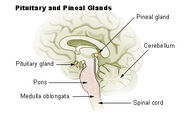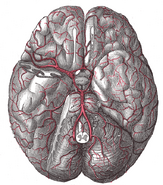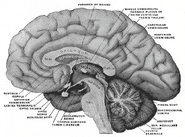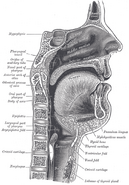No edit summary |
m (Reverted edits by 208.54.38.143 (talk | block) to last version by Dr Joe Kiff) |
||
| (4 intermediate revisions by 2 users not shown) | |||
| Line 20: | Line 20: | ||
DorlandsSuf = 12439692 | |
DorlandsSuf = 12439692 | |
||
}} |
}} |
||
| − | The '''pituitary gland''', or '''hypophysis''', is an [[endocrine gland]] about the size of a pea that sits in a small, bony cavity ( |
+ | The '''pituitary gland''', (or '''hypophysis''' or '''Hypophysis cerebri'''), is an [[endocrine gland]] about the size of a pea that sits in a small, bony cavity (pituitary fossa]) covered by a [[Dura mater|dural]] fold ([[sellar diaphragm]]) at the base of the [[brain]]. The pituitary fossa, in which the pituitary gland sits, is situated in the sphenoid bone in the middle cranial fossa at the base of the [[brain]]. |
It is regarded as the 'master gland' because of its role of regulating the activity of other endocrine glands. The pituitary gland secretes [[hormone]]s regulating [[homeostasis]], including [[trophic hormone]]s that stimulate other endocrine glands. It is functionally connected to the [[hypothalamus]] by the [[median eminence]]. |
It is regarded as the 'master gland' because of its role of regulating the activity of other endocrine glands. The pituitary gland secretes [[hormone]]s regulating [[homeostasis]], including [[trophic hormone]]s that stimulate other endocrine glands. It is functionally connected to the [[hypothalamus]] by the [[median eminence]]. |
||
| Line 35: | Line 35: | ||
===Anterior pituitary (Adenohypophysis)=== |
===Anterior pituitary (Adenohypophysis)=== |
||
| − | The anterior lobe is derived from the [[oral ectoderm]] and is composed of glandular epithelium. The anterior pituitary is functionally linked to the hypothalamus via the |
+ | The anterior lobe is derived from the [[oral ectoderm]] and is composed of glandular epithelium. The anterior pituitary is functionally linked to the hypothalamus via the [[hypothalamo hypophyseal system]] connection in the [[pituitary stalk]]. Through this vascular connection the hypothalamus integrates stimulatory and inhibitory central and peripheral signals to the five [[phenotypically]] distinct pituitary cell types. |
The anterior pituitary hormones, and the hypothalamic hormones that modulate their release are listed below, along with the associated cell types. |
The anterior pituitary hormones, and the hypothalamic hormones that modulate their release are listed below, along with the associated cell types. |
||
| Line 52: | Line 52: | ||
| [[thyroid-stimulating hormone]] || release caused by TRH ([[thyrotropin-releasing hormone]]) || [[Anterior pituitary basophil|basophil]] || [[thyrotrope]] |
| [[thyroid-stimulating hormone]] || release caused by TRH ([[thyrotropin-releasing hormone]]) || [[Anterior pituitary basophil|basophil]] || [[thyrotrope]] |
||
|- |
|- |
||
| − | | [[adrenocorticotropic hormone]] || release caused by CRH ([[corticotropin-releasing hormone]]) || [[chromatophobe]] || [[corticotrope]] |
+ | | [[adrenocorticotropic hormone]] (ACTH) || release caused by CRH ([[corticotropin-releasing hormone]]) || [[chromatophobe]] || [[corticotrope]] |
|- |
|- |
||
| [[endorphin]]s|| - || - || - |
| [[endorphin]]s|| - || - || - |
||
Revision as of 15:17, 6 November 2013
Assessment |
Biopsychology |
Comparative |
Cognitive |
Developmental |
Language |
Individual differences |
Personality |
Philosophy |
Social |
Methods |
Statistics |
Clinical |
Educational |
Industrial |
Professional items |
World psychology |
Biological: Behavioural genetics · Evolutionary psychology · Neuroanatomy · Neurochemistry · Neuroendocrinology · Neuroscience · Psychoneuroimmunology · Physiological Psychology · Psychopharmacology (Index, Outline)
| Pituitary gland | ||
|---|---|---|
| Located at the base of the skull, the pituitary gland is protected by a bony structure called the sella turcica of the sphenoid bone. | ||
| Latin | hypophysis, glandula pituitaria | |
| Gray's | subject #275 1275 | |
| System | ||
| MeSH | A06.407.747 | |
| Median sagittal through the hypophysis of an adult monkey. Semidiagrammatic. | ||
The pituitary gland, (or hypophysis or Hypophysis cerebri), is an endocrine gland about the size of a pea that sits in a small, bony cavity (pituitary fossa]) covered by a dural fold (sellar diaphragm) at the base of the brain. The pituitary fossa, in which the pituitary gland sits, is situated in the sphenoid bone in the middle cranial fossa at the base of the brain.
It is regarded as the 'master gland' because of its role of regulating the activity of other endocrine glands. The pituitary gland secretes hormones regulating homeostasis, including trophic hormones that stimulate other endocrine glands. It is functionally connected to the hypothalamus by the median eminence.
Sections
Located at the base of the brain, the pituitary is functionally linked to the hypothalamus. It is divided into two lobes: the anterior or front lobe (adenohypophysis) and the posterior or rear lobe (neurohypophysis).
Posterior pituitary (neurohypophysis)
The posterior lobe is connected to a part of the brain called the hypothalamus via the infundibulum (or stalk), giving rise to the tuberoinfundibular pathway. Hormones are made in nerve cell bodies positioned in the hypothalamus, and these hormones are then transported down the nerve cell's axons to the posterior pituitary. Hypothalamic neurons fire such hormones, releasing them into the capillaries of the pituitary gland.
The hormones secreted by the posterior pituitary are
- Oxytocin comes from the paraventricular nucleus in the Hypothalamus
- Antidiuretic hormone (ADH - also known as vasopressin and AVP, arginine vasopressin), comes from the supraoptic nucleus in the Hypothalamus
Anterior pituitary (Adenohypophysis)
The anterior lobe is derived from the oral ectoderm and is composed of glandular epithelium. The anterior pituitary is functionally linked to the hypothalamus via the hypothalamo hypophyseal system connection in the pituitary stalk. Through this vascular connection the hypothalamus integrates stimulatory and inhibitory central and peripheral signals to the five phenotypically distinct pituitary cell types.
The anterior pituitary hormones, and the hypothalamic hormones that modulate their release are listed below, along with the associated cell types.
| Anterior pituitary hormone | Hypothalamic hormone | Staining type | Cell type |
| growth hormone | release caused by GHRH (growth hormone releasing hormone) | acidophil | somatotrope |
| prolactin | release INHIBITED by DA (dopamine, "prolactin inhibiting factor"/PIF) | acidophil | lactotroph (or mammotroph) |
| follicle-stimulating hormone | release caused by GnRH (gonadotropin-releasing hormone) | basophil | gonadotrope |
| luteinizing hormone | release caused by GnRH (gonadotropin-releasing hormone) | basophil | gonadotrope |
| thyroid-stimulating hormone | release caused by TRH (thyrotropin-releasing hormone) | basophil | thyrotrope |
| adrenocorticotropic hormone (ACTH) | release caused by CRH (corticotropin-releasing hormone) | chromatophobe | corticotrope |
| endorphins | - | - | - |
The hypothalamic hormones travel to the anterior lobe by way of a special capillary system, called the hypothalamic-hypophyseal portal system.
There is also an interaction between the hormones from the hypothalamus, i.e. TRH induces the release of prolactin.
The control of hormones from the pituitary is in a negative feedback loop. Their release is inhibited by increasing levels of hormones from the target gland on which they act.
Intermediate lobe
There is also an intermediate lobe in many animals. For instance in fish it is believed to control physiological colour change. In adult humans it is just a thin layer of cells between the anterior and posterior pituitary, nearly indistinguishable from the anterior lobe. The intermediate lobe produces melanocyte-stimulating hormone (MSH), although this function is often (imprecisely) attributed to the anterior pituitary.
Functions
The pituitary gland helps control the following body processes:
- Growth
- Blood pressure
- Some aspects of pregnancy and childbirth
- Breast milk production
- Sex organ functions in both women and men
- Thyroid gland function
- The conversion of food into energy (metabolism)
- Water and osmolarity regulation in the body..?
Pathology
Disorders involving the pituitary gland include:
| Condition | Direction | Hormone |
| Acromegaly | overproduction | growth hormone |
| Growth hormone deficiency | underproduction | growth hormone |
| Syndrome of inappropriate antidiuretic hormone | overproduction | vasopressin |
| Diabetes insipidus | underproduction | vasopressin |
| Sheehan syndrome | underproduction | prolactin |
| Pituitary adenoma | overproduction | any pituitary hormone |
| Hypopituitarism | underproduction | any pituitary hormone |
Additional images
See also
- Head and neck anatomy
- Hypophysectomy - pituitary surgery
- Hypothalamo hypophyseal system
- Hypothalmo pituitary adrenal system
- Embryology of the pituitary gland
- Growth and somatotrophin deficiency
- Growth hormone - secretory patterns and control
- Circadian rhythms
- The pineal gland and melatonin
- Autonomic functions of the hypothalamus
- The pituitary and obesity
- Pituitary hormones
References
External links
- BrainInfo at the University of Washington hier-382
- Histology at Boston University 14201loa
- The Pituitary Gland, from the UMM Endocrinology Health Guide
- Oklamoma State, Endocrine System
| Endocrine system - Pituitary gland - edit |
|---|
| Posterior pituitary: Pars nervosa | Median eminence | Infundibular stalk |
| Anterior pituitary: Pars intermedia | Pars tuberalis | Pars distalis | Somatotropes | Lactotropes | Thyrotropes | Gonadotropes | Corticotropes |
Human anatomy, endocrine system: endocrine glands | |||||||||||||||||||||||||
|---|---|---|---|---|---|---|---|---|---|---|---|---|---|---|---|---|---|---|---|---|---|---|---|---|---|
| Hypothalamic/ pituitary axes |
| ||||||||||||||||||||||||
| Pineal gland |
Pinealocyte · Corpora arenacea | ||||||||||||||||||||||||
| Islets of pancreas |
Alpha cell · Beta cell · Delta cell · PP cell · Epsilon cell | ||||||||||||||||||||||||
| This page uses Creative Commons Licensed content from Wikipedia (view authors). |






